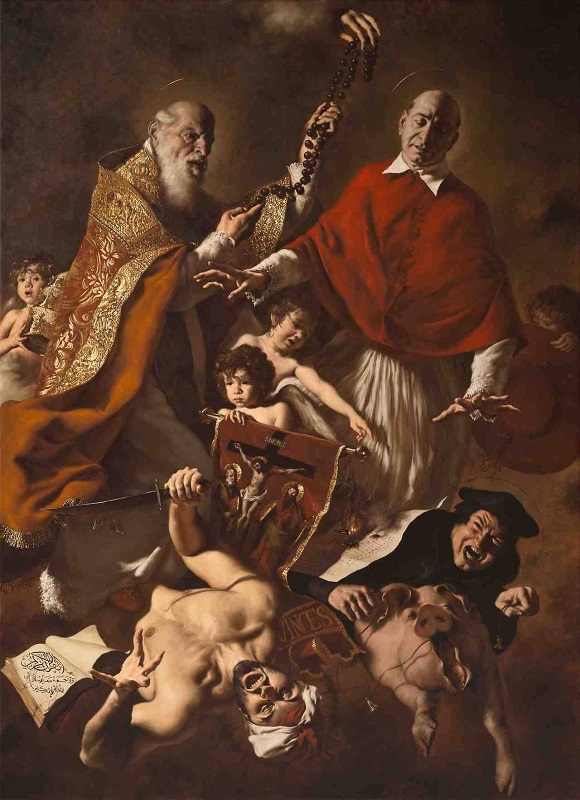
Giovanni Gasparro. St Pius V and St. Charles Borromeo defending Catholicism against Islam and the Protestant Heresy.
[Source]
Let's Adore Jesus-Eucharist! | Home >> Lost Sermons

Giovanni Gasparro. St Pius V and St. Charles Borromeo defending Catholicism against Islam and the Protestant Heresy.
[Source]
Last Sunday (June 13th, 2004), during the Feast of Corpus Christi in the Parish of Très-Saint-Sacrement in Québec City, everybody was given a little Hymn Sheet which contained this excerpt:
The glorious Christ takes the figure of bread and wine to show his corporeal
presence in the Church. The bread and wine of the Eucharist are no longer an
ordinary bread and wine. Of course, their chemical nature remains the same
as that of bread and wine, but, behind this chemical nature we must
recognize by faith the true and new substantial reality of this bread and this
wine: the body and blood of Christ. The Church believes that this bread and
this wine are body and blood of Christ, in this sense that the glorious
Christ takes them to make of them a concrete figure of his presence in
our midst, a venue where he can be found, contemplated, communicated.
[Thurian, Max. The Essentials of Faith, my emphasis]
Please note that neither the homily that day (by Fr. Florent Bourgeault, S.S.S.), nor the "Prions en Église" missalette for that Sunday, nor the parish bulletin, contained any specific and clear assertion of what Transubstantiation is, according to the Catholic Church.
Why, on the very Feast of Corpus Christi, quote an obscure Protestant theologian as the only doctrinal source of information on Transubstantiation? (Thurian started out a Protestant, then was ordained a Catholic Priest, but his Catholicism remained ambiguous at best). Why not a famous and canonized Catholic theologian like St. Thomas Aquinas? Why not one of the innumerable canonized saints who have talked about Jesus-Eucharist, like Saint Jean Vianney (the Curé d'Ars), or Saint Catherine of Siena, or Saint Josémaria Escriva, or Saint Theresa of Lisieux? Why not a respected theologian like Ludwig Ott? Why not the official Catechism of the Catholic Church? Why not the Councils of the Church, whether Vatican II or Trent? Why not the most recent Encyclical by Pope John-Paul II, Ecclesia de Eucharistia, which specifically deals with this issue? And why make the effort to make these bizarre Hymn Sheets available to all at the back of the church, even three days after the Feast of Corpus Christi? (Well, I confess that they are not there anymore, since I stole them today after Wednesday's Mass).
Let us quickly compare the vague and ambiguous statements of Thurian with real Catholic doctrine. This is what Christ, speaking through the Magisterium of our Church, teaches concerning Transubstantiation:
CANON I. - If any one denieth, that, in the sacrament of the most holy Eucharist, are contained truly, really, and substantially, the body and blood together with the soul and divinity of our Lord Jesus Christ, and consequently the whole Christ; but saith that He is only therein as in a sign, or in figure, or virtue; let him be anathema.
CANON II. - If any one saith, that, in the sacred and holy sacrament of
the Eucharist, the substance of the bread and wine remains conjointly with the body
and blood of our Lord Jesus Christ, and denieth that wonderful and singular conversion
of the whole substance of the bread into the Body, and of the whole substance of the
wine into the Blood-the species Only of the bread and wine remaining-which conversion
indeed the Catholic Church most aptly calls Transubstantiation; let him be anathema.
[Council of Trent, Thirteenth Session]
Compare this with the quote from Max Thurian. Remember that for inanimate bodies (like a rock, or water, or bread or wine), the substance of that body is what has a chemical nature. Water is water, its chemical nature is composed of two atoms of Hydrogen and one atom of Oxygen, H2O. If the chemical nature of water is transformed into the chemical nature of water, nothing has essentially or substantially changed! It is still just plain water! Same thing for wine or bread.
If the supplied quote is exact and representative, then it seems Thurian denies Transubstantiation, and claims that the presence of Christ is only a "figure", not the real thing. At worst, this is a blatant heresy, and one of the worst you can come up with. At best, it's a seriously ambiguous and reckless statement.
The Catholic Church protects and faithfully transmits the pure and integral faith of the Apostles, who themselves received it from Christ. The Catholic Church has always taught, teaches and will forever teach that after consecration, what is in the Priest's hands is not bread or wine anymore, it is God Almighty, Jesus Christ, second Person of the Most Holy Trinity, True Man and True God, co-eternal and co-substantial with the Father and the Holy Spirit.
Jesus Christ is not present in the Eucharist as a symbol or a figure. He is really, truly, substantially present. You must adore Him, for He is the Lord. You can talk to Him, thank Him, praise Him, pray Him. He is really present, hears you, and loves you. When you go to communion (in a state of grace, of course!), you don't get bread and wine, but Jesus Christ, under the appearances of bread and wine. What we call the accidents of the bread and wine remain (everything we can perceive with our senses and our modern scientific instruments), but the substance has totally changed. If you can't understand that, don't worry. It is a mystery and a miracle, made by God Almighty.
Don't let the silly invocation of Thurian "trans-Protestantize" your Catholic Faith into a stupid heresy!
Let's Adore Jesus-Eucharist! | Home >> Lost Sermons